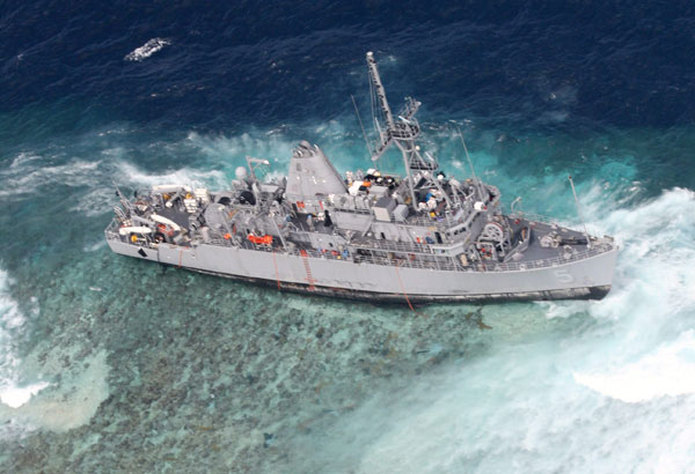 USS Guardian on Tubbataha Reef - click for The Philippine Star story
USS Guardian on Tubbataha Reef - click for The Philippine Star story Last week several intense activities I started last winter finally ended for the summer, and another less important one was ruthlessly terminated by me. I now have room to breath. I wasn't entirely happy with all the work; but having taken on the responsibilities, I didn't want to abandon them.
I suppose everyone has been in that spot from time to time. Sometimes, at the moment you say “Yes!” it’s hard to visualize all the time and effort some very good cause might require. Just because it's a good thing for somebody to do doesn't mean that it's a good thing for you to do!
A lot of maritime news has rolled under the bridge since my last post. One that interested me was the account of USS Porter colliding with a tanker in the Straits of Hormuz – this recording of the bridge audio would get any mariner's heart pounding.
I wonder whether a similar groupthink mindset played into the Tubbataha Reef grounding of the USS Guardian, although the situations were clearly different?
In both cases it seemed the momentum of the large bridge teams involved carried things forward into danger; almost as if each individual on the team was thinking, “with all the people on the bridge right now, we must have everything covered”. Or perhaps even, “this is someone else’s responsibility”. To judge by the recording of the USS Porter, it seemed the officers on the bridge might have been afraid to cross their excited commander, even when they became aware that the ship was standing into danger.
In each case, also, situational awareness was wanting. In the USS Guardian case, the Digital Nautical Charts were found to have inaccuracies - but how about keeping a lookout? Did the watch team “neglect. . . any precaution which may be required by the ordinary practice of seamen”? And in the USS Porter collision, the commander wasn't made aware of the approaching tanker until collision was inevitable.
Of course, Navy ships have their own bridge culture. I don’t know it well, and won’t presume to correct their way of operating. They safely cover a lot of sea miles, and handle precise maneuvers such as unrep with great skill. Overall, they are obviously doing many things right.
But those two episodes took me back to my early days at sea, when I had a friend who joined the Navy Reserve. This fellow was a licensed Master; held pilotage for Delaware Bay among other routes; and although young, was a capable, experienced mariner. He was on the bridge during a Reserve cruise; the ship was transiting up Delaware Bay, and various Reserve officers were taking turns conning the ship. When it came my friend’s turn he was told to take the ship around the next mark. He felt fine about that - he’d piloted ships up that same channel many times as a civilian. But he reckoned without the “Navy Way”.
Now, anyone who has endured Navy training will remember the phrase, “there’s the right way, the wrong way and the Navy way - we do things the Navy way!” Translation: “don’t question how we’re doing this, or bring your own ideas into this operation - you do it our way.”
In this case, as explained to me by my buddy, the Navy way is that the bridge team is supposed to work together as the ship approaches her turn, plotting positions and calling off ranges something like this: “1000 yards to turn - 500 yards to turn - 300 yards to turn” and so on until the turning point is reached, when it’s something like “initiate turn”. Apparently quite a procedure; any of you Navy guys out there who know the exact procedure please comment below and tell us how you do it today, as it’s been many years since I heard that story.
Regardless of this being the “Navy way”, however, my friend was a trained, licensed professional Pilot and really felt that he knew how to handle this job. Here was his method: watch the ship approach the mark; at the appropriate moment, say “Right 20 - ease to 10 - amidships. . . steady”. Period. He completed the maneuver safely - and was promptly thrown off the conn “until you can learn to do it properly”. With some difficulty, he kept his mouth shut.
I’m not knocking the Navy, though that's a funny story. But I do wonder about the effect of such large bridge teams. I think there may have been a similar “crowded bridge” effect at work during the Costa Concordia disaster. Maybe having a lone Mate on watch, bereft of even a lookout, is going too far in the opposite direction! But at least that lone Mate knows who’s responsible for the ship’s navigation. I think it would take strong leadership and focus by the OOW on a Navy bridge to maintain the team’s focus, shut out static, and effectively use all those resources. Maybe that was lacking in these two cases.
Have you had any experiences with large bridge teams? Can you tell us about it? Please comment below!
 RSS Feed
RSS Feed